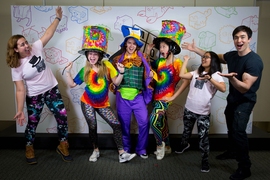Most engineers first discover their affinity for engineering in childhood. Long before they use CAD software or a lathe, they get hands-on design and making experience playing with toys.
For Amanda Garofalo, a sophomore studying mechanical engineering, it was Legos and K’nex. “Growing up my brother and I used to design roller coasters with K’nex and design entire cities using Legos all over our house,” she recalls.
Last spring, Garofalo had an opportunity to engage in hands-on play again. This time, as a student in 2.00b (Toy Product Design), an introductory class offered by MIT’s Department of Mechanical Engineering.
“When it comes to learning, motivation is key,” explains David Wallace, professor of mechanical engineering and instructor of course 2.00b. “We create a fun environment in which students aren’t afraid. They’re super motivated and driven to succeed.”
The first lecture of the semester establishes that fun environment. Students enter a classroom filled gift-wrapped boxes, each containing a different toy. They then examine what about the toy engenders fun.
The backbone of the class is a group project. Eighty students are divided into teams of five. By the end of the semester, each team must produce a toy that they unveil at the class’ final presentation — or PLAYsentation. Throughout the semester they learn the various stages of the product design process — from ideation and modeling to iteration and user testing.
For Josh Ramos, a lecturer of mechanical engineering, there are few topics better suited to introduce students to product design than toys. “Toys are something everyone has experience with,” he adds. “There are a lot of other engineering-related projects you could teach in a first-year class, but very few projects are about something students are already so familiar with.”
Ramos works in MIT’s Product Design Lab, where students learn how to safely use the various tools and machines they’ll need to create their products. He helps oversee one of the first lab activities in which students make a simple wooden pull toy. For many students, including Garofalo, this is their first opportunity to use a bandsaw or drill press.
“The toy industry is real science,” adds Georgia Van de Zande, a lecturer for the class. “There is a lot of engineering that goes into making toys durable but also whimsical and fun for kids.”
The science of toy making starts with ideation. Students are given a general theme to inspire them. Last year, students were instructed to make a toy around the theme of “Dream.”
“We did rapid ideation and came up with 150 ideas of toys related to dreams and nightmares,” says Garofalo. “We picked our favorite three and made a ‘looks-like’ model and a ‘plays-like’ model.”
The next step in the process is playtesting, which is conducted across the river at the Boston Children’s Museum. Garofalo and the rest of her team tested their product with a group of children at the museum. “The best part about that experience was putting the toy down, not giving the kids any instructions, and seeing what they would do with it,” she adds.
Her team’s toy, the Mad Hatter, is a colorful tie-dyed hat that throws and catches balls. After playtesting it several times, she and her group made several modifications based on the children’s feedback, including adding an electronic ping that let the players know when they successfully caught a ball.
This process of iteration gives students real-life experience with product design. “The 2.00b class progression is modeled after a design process that you might experience in industry — one that's condensed into a single semester,” adds Victor Hung, also a lecturer for the class.
As students work on their final product, they are also tasked with finding a creative way to present their toy. Groups perform skits to introduce their products to an audience of their peers. These skits help hone communication skills that will be instrumental as their academic career progresses.
“One of our main goals with this class is to get students excited about engineering,” says Ramos.
In Amanda Garofalo’s case, 2.00b certainly achieved that goal. “Getting to prototype in this class made me realize how much I like building things and helped me choose Course 2 as my major,” she explains.
The hands-on experiences she had in 2.00b is something she is already carrying with her into her other classes in mechanical engineering. “The hands-on, physical experiences in 2.00b has helped me understand the theory in my other classes so much better,” she adds.
Toy Product Design is offered to first-year students each spring in the Department of Mechanical Engineering.











